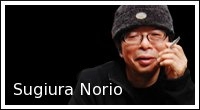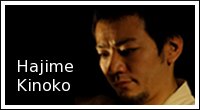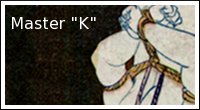A Seminal Work on Kinbaku

As far back as I go with The City of Angles, I'm surprised I neither bumped into nor heard of an individual who refers to himself as Master "K". I first learned of him after coming to Japan -- through the internet, of course.
As a scholar and historian, Master "K" spends surprisingly little time on the internet with the possible exception of email. He does his research the old fashioned way, burying himself in ancient and obscure texts, many written in a form of Japanese that isn't common today. While he acknowledges that his Japanese accent could use some help, he excels at reading and comprehending the Chinese characters that were committed to paper by Japanese characters whom the centuries have forgotten.
Master K's subject, and his fascination, is kinbaku -- as it has been for over three decades. Almost as an afterthought, he wrote a book. He says it dawned on him one day that he was in the unique position to write something on the topic that he would like to read.
The book is called The Beauty of Kinbaku.
Hit the Read More link for an interview with Master "K", the unassuming author of an imposing work on the subject of kinbaku.
KabukiJoe: What is the origin of your handle Master "K"?
Master "K": I was first called this by my kinbaku teacher for an introduction at a satsusei kai (photo/art meeting/club) in Tokyo in the 1970s. I've kept
it ever since.
What brought you to Japan in the first place in the 70s?
I was a student.
Have you made many trips to Japan since?
A few.
How many trips and how do you spend your time mostly?
I came as a student, then again a year after graduation to stay with friends for half a year. After that I returned once more for a very short stay with my oldest Japanese friend during one of his four times yearly trips home. He is based in the U.S. for his Japanese company.
It sounds like your spoken Japanese is at a functional level while your reading/writing abilities are superior. Assuming this is correct, it seems inverted to me. By that I mean, for most people it's the opposite. To what do you attribute this?
It's really not that surprising. I'm a scholar first so most of my time is spent with books and documents. Besides, I'm told I have a terrible Japanese accent!
How in the world were you able to come into possession of the full run of Kitan Club and other legendary magazine titles?
 It wasn't that difficult. You must remember that I was in Japan in the early 1970s when Kitan Club was still publishing. Over the years my many contacts have helped me add to my collection. What is perhaps more significant is that my archive also includes complete runs, or almost complete runs, of all the other major SM/kinbaku magazines: Uramado, SM Kitan, Abu Hunter, SM Collector, SM King, Fuzoku Kitan, etc., etc. It is these sources that added so much material to my new book, The Beauty of Kinbaku.
It wasn't that difficult. You must remember that I was in Japan in the early 1970s when Kitan Club was still publishing. Over the years my many contacts have helped me add to my collection. What is perhaps more significant is that my archive also includes complete runs, or almost complete runs, of all the other major SM/kinbaku magazines: Uramado, SM Kitan, Abu Hunter, SM Collector, SM King, Fuzoku Kitan, etc., etc. It is these sources that added so much material to my new book, The Beauty of Kinbaku.Could you give a little additional background on Kitan Club?
Kitan Club was the most famous Japanese SM magazine. It launched the careers of Minomura Kou and Tsujimura Takashi, Oniroku Dan and many other famous writers and illustrators. It was groundbreaking in its importance in the evolution of Japanese SM and kinbaku. By the way, one of my greatest days as a collector was finding 57 vintage issues in the trash.
Say again! How did this come about?
My teacher invited me to a kinbaku event at a publishing concern. The magazines were duplicate issues from the company's office library that were being tossed out to make room! I strained my back carrying them back to my digs and they cost a fortune (for me as a student) to ship home. I've never regretted it.
What does "Kitan" mean?
The name is taken from the abbreviation of the word "ibunkitan" meaning "strange stories" or "curious tales." By the way, like many facts in my book, this little detail took months to uncover so I hope my publisher won't be too unhappy if I reveal a couple of closely guarded secrets from the book!
Do you know the details of their shut-down in the 1950s?
It was a complicated story. Basically, Kitan Club was singled out due to its notoriety and suffered censorship problems not just in the 1950s but on and off throughout its history.
Minomura Kou was famously connected to Kitan Club but he wasn't the founder, right? Who was the actual founder? Actually, as I recall, Kitan Club started out as a different kind of magazine and then morphed into an SM magazine. Is that correct?
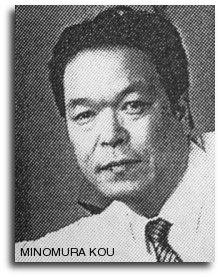 The publisher was Yoshida Minoru. It started as a tabloid magazine in Osaka after the war but turned to SM due to public interest generated by the art of Minomura Kou and many other factors. I cover the magazine's complete story in my new book using many different sources of information: Nureki Chimuo, Saotome Hiromi, etc.
The publisher was Yoshida Minoru. It started as a tabloid magazine in Osaka after the war but turned to SM due to public interest generated by the art of Minomura Kou and many other factors. I cover the magazine's complete story in my new book using many different sources of information: Nureki Chimuo, Saotome Hiromi, etc.How do you go about doing your research?
It's a lot of work. As I've said, my skills in Japanese are in reading and comprehending written texts. I've been doing this for over thirty years now and derive a tremendous amount of pleasure from spending an inordinate amount of time deciphering historical manuscripts. I hold a degree in Asian studies so all of this research comes second nature to me.
All this aside, I should say that these qualifications aren't all that relevant regarding the accuracy of the research that went into my latest book because I never relied completely on my own translations for that project. Instead, for the four years of writing the book I collaborated with four main, uniquely qualified translator/partners and several other associate translators to: 1.) Back up all of my conclusions. 2.) Provide their own expert translations of modern and historical documents. 3.) Guarantee corroboration and authentication for all translations that I did of the historical documents and interviews used as the basis for the book. The cost for doing this ran into the many thousands of dollars.
Having a high level of written Japanese, did you send letters to Japan, email, make research trips?
All of the above.
How large is your library/archive?
Including all fine art, documents, books, magazines, sculptures and audio/video materials, my archive holds well over 4000 items.
When did you first become interested in bondage and then Japanese bondage in particular? I, for example, came across magazines such as Sapporo Bondage and Osaka Bondage in the 70s. These magazines had legitimate, full-color pictures imported from Japan.
 I was 16 and went into a shop in San Francisco where I saw a book of kinbaku images and a book of John Willie's art. It was then I realized my interest was shared by many others and that it could be art. My interest in Japanese history and culture came later. By the way, I have all the magazines you mention in my collection. They were part of the exchange of materials from Phoenix Co. (a Japanese company), as well as other Japanese companies, and various "adult" publishers here in the U.S. Most of the pictures were professional photo shoots done by people like Minomura Kou but some were private satsusei kai pictures.
I was 16 and went into a shop in San Francisco where I saw a book of kinbaku images and a book of John Willie's art. It was then I realized my interest was shared by many others and that it could be art. My interest in Japanese history and culture came later. By the way, I have all the magazines you mention in my collection. They were part of the exchange of materials from Phoenix Co. (a Japanese company), as well as other Japanese companies, and various "adult" publishers here in the U.S. Most of the pictures were professional photo shoots done by people like Minomura Kou but some were private satsusei kai pictures.How has your practical knowledge of working with rope come about?
Years of study and constant practice beginning with my first teacher, a lovely guy who was a hanger-on at the fringes of the Japanese SM world in the 70s.
Have you had any hands-on experience or contact with any of the venerable masters we admire so much today, e.g., Nureki Chimuo?
Certainly. Through my own teacher and via interviews, letters, e-mails, phone calls, books, contacts with their students and associates, etc. For instance, for the book Nureki, Nagaike, Sugiura, Miyabi, etc., were all interviewed as were many of their associates. My good friend Osada Steve was extremely generous in sharing information about his sensei, the late Osada Eikichi, and in passing on comments from Yukimura Haruki. My materials come from many different sources.
It is said that modern kinbaku comes from hojojutsu. Do we know approximately when hojojutsu came about?
This is another question and subject I cover extensively in the book but, yes, hojojutsu is one, but not the only, important ancestor of modern kinbaku. It began to evolve as a serious martial art in the late 15th century.
Are there 500 ties, basically, in hojojutsu?
Oh, yes. Probably more. Many have been lost due to the destruction of records and the disappearance of many hojojutsu ryu (schools).
Why would these ties be guarded, kept secret?
Simple. As with all martial arts training, the various ryu didn't want their secret techniques falling into opposition or rival hands. When hojojutsu became one of the basic law enforcement techniques during the Edo era (1603-1868), officers didn't want criminals learning the binding secrets for fear they'd escape.
Do you ever ponder the resemblance of hojojutsu to martial arts? I guess that's not strange since hojojutsu is considered a martial art.
Hojojutsu has many of the classic aspects of the more well-known martial arts and must be learned the same way. For instance, there are numerous hidden techniques that must be carefully studied because they have a direct bearing on performing safe, modern kinbaku.
Wasn't hojojutsu fairly basic, utilitarian? I know there were certain rules to follow as to how to tie which kind of prisoner.
 It's a good example of the form follows function idea. Hojojutsu was "utilitarian" when it had to be during the practice of hayanawa (fast or arresting rope ties) and complex when used for honnawa (official rope/ties). For instance, the careful binding of prisoners according to class was an important part of honnawa hojojutsu.
It's a good example of the form follows function idea. Hojojutsu was "utilitarian" when it had to be during the practice of hayanawa (fast or arresting rope ties) and complex when used for honnawa (official rope/ties). For instance, the careful binding of prisoners according to class was an important part of honnawa hojojutsu.But aren't the fancy patterns we often see today a bit show-offish? By that I mean, it seems to me these patterns are there to show what wonderful skills the guy tying the ropes has. I would prefer the nawashi stay in the background. I want to focus on a bound woman, not be distracted by so many fancy patterns.
Show-offish? In hojojutsu? No, the "fancy patterns" were a vital part of honnawa. In feudal days these ties were not intended to be erotic but rather were effective means of capture, the display of different classes of prisoner or were used for their secure transportation. Today's complex kinbaku ties are the descendants of this style.
But wouldn't a hojojutsu guy be rolling over in his grave looking at some of this fancy stuff -- work I am tempted to label "macrame-ryu"?
Ah! I understand now. Your misunderstanding is precisely one of the reasons I wrote my new book! Many Western rope lovers only have partial information (due to flawed internet sources or incomplete lectures by "experts") about hojojutsu and kinbaku and how these two interesting Japanese rope traditions are linked. From your questions I see that you don't know there was an arresting style of hojojutsu (hayanawa) and a more formal style (honnawa) used for differentiating the classes, transporting prisoners, etc.
All right. But I've seen people do ties that took 15 minutes (or longer) to complete, adding rope upon rope. Erotically, I do like this if it doesn't go too far. Don't you think this is going too far?
Not at all. Kinbaku is a very elastic art and encompasses many different styles and techniques. The key is whether these are done well or not. For example, in expert erotic kinbaku taking more time can be similar to a lengthy caress or foreplay between lovers and also it's necessary for creating beautiful and complex rope patterns, if that's what the bakushi and his partner want to do.
And you're saying this is still related to hojojutsu?
Of course. These "complex" styles were, as I've just mentioned, part of honnawa hojojutsu and this tradition has been incorporated into modern kinbaku. In the Edo era these ties would be carefully applied with several constables in attendance guarding the prisoner.
Would a hojojutsu guy use more rope than was necessary to accomplish the task of binding or torturing?
 No. However, arresting hojojutsu was different from the styles used for the presentation/display of prisoners and their transportation and both were different from the bindings done for torture. These latter were codified in 1742 as "The Official Punishments" and included being beaten while bound, pressing with stones, the ebi and suspensions. This is a separate category of tying. There was even one ryu, the Ishii-ryu, that specialized in ties for torture. I go into detail on this in my book.
No. However, arresting hojojutsu was different from the styles used for the presentation/display of prisoners and their transportation and both were different from the bindings done for torture. These latter were codified in 1742 as "The Official Punishments" and included being beaten while bound, pressing with stones, the ebi and suspensions. This is a separate category of tying. There was even one ryu, the Ishii-ryu, that specialized in ties for torture. I go into detail on this in my book.I know Japan has a very aesthetics-oriented culture. They seem to be capable of turning just about anything into an art form. And function very often follows form. But was hojojutsu considered any kind of art form back in the day, or was it simply a practical method for accomplishing an end?
It was both. It was intensely practical but, at least in the Edo era, one of the four imperatives of proper hojojutsu technique was that it "must be beautiful to look at." Sloppy tying (except during the struggle of an arrest) would bring disgrace upon the officers involved.
I had always thought that hojojutsu was merely a practical, simple and no-nonsense (albeit codified) method of binding and torturing. No fancy stuff.
Again, your conclusion simply speaks to your lack of access to good information. I show a number of beautiful hojojutsu patterns in my book and I assure you they are all authentic.
I don't have a problem with people who enjoy the "beauty" of Japanese style bondage. I sure hear this term a lot. But it sounds to me like they're soft-pedaling something whose intent wasn't beauty, and then claim hojojutsu roots. I've seen fancy schmancy ties that just seem ludicrous to me, even in Japan.
And now that I'm warmed up, I think some of this over-emphasis on aesthetics may be traced to what I call the "feminization" of shibari. When I look at the shibari of some women out there, it looks like the shibari is an after-thought. By that I mean, the kimono, the tatami, the shoji, the flowers, the perfect hair, blah, blah, blah, are all there and then they throw on some ropes -- admittedly, skillfully -- but, jeez, you could leave the ropes off and sell the picture.
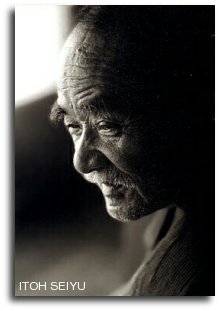 Kinbaku is an art that has its origins in the distant past and almost everything that's done today can be traced back to some element found in Japanese history. Techniques improve of course, especially as regards safety, but the foundations were well established by Itoh's (Itoh Seiyu, 1882-1961) day.
Kinbaku is an art that has its origins in the distant past and almost everything that's done today can be traced back to some element found in Japanese history. Techniques improve of course, especially as regards safety, but the foundations were well established by Itoh's (Itoh Seiyu, 1882-1961) day. As for the "feminization" of kinbaku, you're certainly entitled to your opinion and I agree that some overly-delicate photos produced by some photo studios seem devoid of passion and can almost seem comic in their concentration on "refined aestheticism." On the other hand, it must be remembered that the great Akechi Denki sensei was one of the most ferocious and powerful nawashi ever, and yet he was extremely concerned with doing attractive ties and was fascinated by hojojutsu. One of the beauties of kinbaku is its diversity.
Is there anyone in the modern era who can claim any sort of "lineage" when it comes to shibari? Randa Mai learned from books. The same with Akechi Denki. They studied printed material, just like people do today. What lineage would they be able to claim? Who was their master? Who was their master's master, and so on?
This is the exact question a reader sent to me and I answered in The Beauty of Kinbaku. Let me quote from my book:
Question: "If shibari/kinbaku has some of its origins in hojojutsu, how come we can't trace specific shibari/kinbaku masters to the heads of the various, historical martial arts schools?"
Answer: "Well, actually, we can, in a way. With the Meiji restoration in 1868 and the rush to modernize, the samurai class was abolished and with it most of the hojojutsu schools that trained them. By the early 20th century, almost all vestiges of that feudal world were gone.
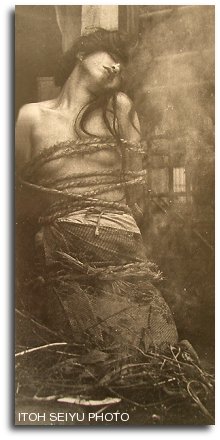 However, when Itoh Seiyu began his explorations of seme (torment), we know from the various testimonies of his colleagues and the many study photos and sketches he produced and left behind, that he had learned hojojutsu skills from an original practitioner and applied those to his researches. Itoh, in turn, passed on many of these techniques and designs to others, including Minomura Kou (Kita Reiko) who was a member of Itoh's circle. Minomura, in turn, influenced Nureki Chimuo and Dan Oniroku and they have influenced many, many more. And so it goes."
However, when Itoh Seiyu began his explorations of seme (torment), we know from the various testimonies of his colleagues and the many study photos and sketches he produced and left behind, that he had learned hojojutsu skills from an original practitioner and applied those to his researches. Itoh, in turn, passed on many of these techniques and designs to others, including Minomura Kou (Kita Reiko) who was a member of Itoh's circle. Minomura, in turn, influenced Nureki Chimuo and Dan Oniroku and they have influenced many, many more. And so it goes."I should also point out that just because a kinbaku practitioner learns from a book doesn't mean he hasn't learned from a master. One of the best books on hojojutsu, for instance, is by the great martial artist Fujita Seiko. Anyone learning from him, even through his wonderful book, is in contact with the real deal.
Regarding Itoh Seiyu: Was there anyone at all like him either before his time or around his time?
Doing hojojutsu? Yes, there were many hojojutsu ryu in the 19th century when Itoh was born and, after the fall of the shoguns, the Meiji and Taisho era police continued to use some hojojutsu techniques. Fujita Seiko's father was a constable. By the way, this is where Fujita got all those patterns for his encyclopedic book!
Apparently, the consensus back then was that Itoh Seiyu was a "pervert" and yet he and his practices were tolerated. What were the attitudes of Japanese society in the early years of the 20th century?
Itoh was certainly a pioneer of erotic shibari and seme-e (torment art). However, my impression is that Itoh courted the "rebel outsider" label and often complained about his getting "little respect." In some ways it was a pose. While the society of his day was basically conservative, Itoh did get a lot of mainstream publicity and not a few important commissions. Towards the end of his life he was even commissioned to do several erotic paintings for a famous Buddhist temple and the police once asked him to teach a hojojutsu class on tying with one foot of rope/string!
Also, Itoh was not alone in his interests. There were others and he had numerous disciples. Itoh was just the most famous figure doing erotic SM type material at the beginning of the 20th century. I have a complete biography of Itoh in my book that tells many other fascinating anecdotes about him and also lists all his major publications.
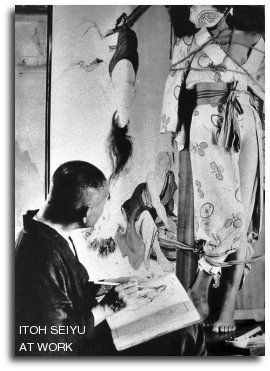 What about his wives? I believe he was married twice. He seems to have been quite fond of his first wife, though they separated. I wonder why?
What about his wives? I believe he was married twice. He seems to have been quite fond of his first wife, though they separated. I wonder why?No, your information is somewhat incorrect. He actually married three times. Itoh and his first wife were incompatable and separated. It was his second wife (Kiseko, aka Kisse) who was the submissive and parcipitated in Itoh's famous (or infamous) snow and pregnant suspension stunts.
But he bound both of them (the first two wives) for his purposes?
No, this isn't true. Itoh's first wife had no interest in SM or bondage. Before Itoh married his second wife, his model was the beautiful Oyou, a model so famous she has her own biography. She finally left Itoh and became well known in her own right in fine art circles for modeling for three remarkable artists: Itoh, Fujishima Takeji and Takehisa Yumeji.
So his second wife was pregnant?
Yes, Kisse is the model for the remarkable photo where he attempted to recreate Yoshitoshi's famous print "The Lonely House on Adachi Moor." That was the print that showed a pregnant girl suspended upside down and was one of the most controversial works of Yoshitoshi's career. Itoh, an admirer of Yoshitoshi, was a very driven fellow.
Do we have any information at all about his offspring?
We know Itoh had a son who was killed in World War II and a daughter, Kiku, who suffered from mental illness and that Itoh struggled hard to support her later in his life. She also cooperated in the publication of several important books on her father beginning in the 1990s. My new book's bibliography has a complete listing of all of these.
It boggles my mind that a Japanese woman would allow herself to be photographed nude and in bondage in the early part of the 20th century. It seems the earliest this was possible in the U.S. was in the 50s. Furthermore, it appears he (Itoh) didn't suffer persecution except for the pervert tag, although he said he was visited by the Japanese police when his photos were mixed in with photos of charred bodies after the Great Kanto earthquake. Was it then that he was put in jail?
You must remember that the early 1920s in Japan (and elsewhere) was a time of avant-garde artistic experimentation. In Japan the Ero-Guro (Erotic Grotesque) movement combined sexual themes and early SM in their literature and art. Itoh, while not part of this movement, certainly was a man of his times. The United States, by contrast, was more conservative.
Having said that, Itoh was arrested at least twice; once for publishing "obscene materials" of an SM type and once for publishing drawings that were considered disrespectful to Confucianism. Both times he was incarcerated only briefly. Later in life his relationship with the authorities changed completely and he did a book on Edo era justice in cooperation with the police museum, was asked to contribute to an anti-crime exhibit and to give tying demonstrations to police classes, as I mentioned earlier.
What did he do when he got out of jail?
Itoh just kept on doing what he'd always done. He was indefatigable.
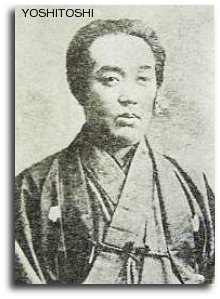 As you mentioned, Itoh Seiyu was influenced by the great woodblock artist Yoshitoshi. Yoshitoshi's master was Utagawa Kuniyoshi. I have read that Kuniyoshi did many seme-e (torment art) prints as well and yet I can't find a single one online (although many of his other works appear). Are you very familiar with Kuniyoshi's seme-e work?
As you mentioned, Itoh Seiyu was influenced by the great woodblock artist Yoshitoshi. Yoshitoshi's master was Utagawa Kuniyoshi. I have read that Kuniyoshi did many seme-e (torment art) prints as well and yet I can't find a single one online (although many of his other works appear). Are you very familiar with Kuniyoshi's seme-e work?Oh yes. Most of the shunga depicting seme-e material, like most of the useful, reliable info on kinbaku, is never seen online. A few of this artist's shunga seme-e have been reprinted in Japanese art books and quite rarely in English ones (see Marco Fagioli). As with all of this material, it takes a lot of work to ferret it out.
I'm curious about the gap that seems to exist between historical hojojutsu and modern shibari. There was World War II, of course, but I have the impression that info on hojojutsu is sparse prior to WWII going back, perhaps, to somewhere in the 1800s. How big is this gap and why do you think it exists?
It doesn't exist. Hojojutsu techniques were well known by many martial arts practitioners for centuries. Itoh just began using them for erotic SM studies.
People have funny ideas when it comes to Japan. They think shibari stuff is all over the place, out in the open. Why do you think this is?
Partly this is the tradition/myth of the mysterious, sexually advanced East and partly it is true that more examples of this type of erotic material, both pornographic junk and interesting art, are somewhat more widely available in Japan than in the West.
Your first book, Shibari, The Art of Japanese Bondage, came out four years ago. How is your new book, The Beauty of Kinbaku, different from the first?
The first book was a photo book that included a short essay on the history of shibari/kinbaku. The new book is far more ambitious and has 10 times the information and twice as many photos.
Is it the case that The Beauty of Kinbaku has a press run of 1,000 copies?
Yes.
Will there be a second edition if/when it sells out?
No. There are no plans to publish a second or a paperback edition. The reason is that I wanted this book to be a museum quality publication and have the highest quality reproduction of photos and illustrations. This wouldn't be the case in a paperback book. Also, quite frankly, it is doubtful that given the current economic climate a publisher would risk putting out another edition of an art/history book on so arcane a subject. As we all know, the world of kinbaku is a very small place.
Truthfully, I feel very fortunate that The Beauty of Kinbaku has appeared at all. It nearly didn't. It only saw the light of day because at the time of the economic downturn the book was already at the printers and so it was too late for the publisher to change his mind about releasing so risky a book! Dumb luck!
What inspired you most to write the second book?
After the first book came out and was successful, I was often asked if I would do a more complete history of Japanese erotic shibari. It finally occurred to me that I could make a useful contribution to the study of kinbaku due to the sheer coincidence of when I first went to Japan and long ago began to learn about, research and collect historical materials on this fascinating erotic art form. In short, I realized I was in a position to write the book I always wanted to read. That's why I did it.
What is different about The Beauty of Kinbaku from any other book on the market?
This really isn't for me to say. However, if pressed, I'd say that if there's a unique quality to The Beauty of Kinbaku, it's in the synthesis of information from a vast number of sources that has gone into presenting, for the first time in English or Japanese, a complete picture of the evolution of the art of shibari/kinbaku through time. I joked with a friend recently that my book took "30 years of collecting and study and 4 years of fact checking" to write and this is only a slight exaggeration.
 Has any other book (in English or another foreign language) been accepted into the Fuzoku Shiryoukan (SM Library) in Tokyo?
Has any other book (in English or another foreign language) been accepted into the Fuzoku Shiryoukan (SM Library) in Tokyo?I believe the only other English language books they have are several historical 19th century texts on flagellation.
What does this mean to you?
I'm honored all the more.
Could you give us a little background on the Fuzoku Shiryoukan?
My pleasure. The SM Library (Fuzoku Shiryoukan) is a unique institution. Founded in 1984, it is the most famous library devoted to sadomasochism in the world. It holds over 17,000 volumes and more than 2,000 videos and DVDs on this subject, including many unique historical texts. It also houses one of the largest portfolios of original art by the legendary Itoh Seiyu to be found anywhere in the world.
How many pages does your new book have?
It has 192 illustrated pages.
How many photos?
202
Color? Black and white?
Both. There are many very rare historical black and white photos used to illustrate the text but all the "Gallery" photos are in color.
Can you give some samples of chapter titles?
The book is divided into seven chapters: An extensive History (including a discussion of tying in the culture of Japan, the origins of hojojutsu and the "Official Punishments," the rise of the SM magazines in post-war Japan, the story of Itoh, etc.); Twenty-five key figures in shibari/kinbaku history (Yoshitoshi, Minomura, Tsujimura, Akechi Denki, Sugiura, Nureki, Ozuma, etc.); a Gallery of 109 kinbaku photographs; a Glossary of shibari terms (the largest ever published in English); a How-to-Tie section; an Afterward and, finally, an extensive Bibliography of most of the significant books relating to shibari/kinbaku ever published in English, Japanese, French, German, etc.
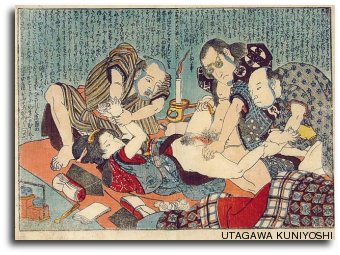 If you had it to do over again, would you include the how-to section? I forget the issue here but someone on one of the bondage groups was criticizing something about this section. I believe you addressed this in your Graydancer podcast, but perhaps you could elaborate a bit.
If you had it to do over again, would you include the how-to section? I forget the issue here but someone on one of the bondage groups was criticizing something about this section. I believe you addressed this in your Graydancer podcast, but perhaps you could elaborate a bit.I'm not sure I understand your question. The how-to section was necessary because the book is intended as a complete guide to the art of kinbaku. That chapter is a non-threatening introduction for readers new to the art. The patterns offered are a standard gote, an agura and a hishi shibari. In other words, a simple "essential tie," an easy to do "predicament tie" and an attractive "pattern tie." They're safe and easy to do. However, I also include a lot of additional information in the chapter (i.e., how to do a "safety release knot," what type of rope is best, etc., etc.) that would probably be of interest to most practitioners regardless of their experience level. As for the pictures, they're in black and white but are very clear and larger that those in Nureki's famous Bondage Seminar book and are about the same as those in several of Arisue Go's early lesson books. Someday I might write a true how-to volume including advanced ties but the chapter in this book is generally intended for interested beginners.
You said that you have been researching kinbaku for 30 years and it took four years to write the book. It sounds like the quintessential labor of love.
The Beauty of Kinbaku was written by a kinbaku lover for other kinbaku lovers and I hope it will be accepted as such.
Are you able to impart your knowledge of contemporary and historical kinbaku in other ways other than through your books?
Oh yes. I get a great deal of satisfaction from my private teaching.
Are you contemplating another book. If so, what direction do you think it will take?
Four years of work is enough! Seriously, I never say never but I have no plans to do another shibari/kinbaku book at the moment.
As I understand it, the book is only available at the official website for now. It will then become available in some stores.
Yes, this is correct. However, I'm not sure when this will happen. That's up to my publisher's marketing people. The truth is only 1000 copies were printed and when they're gone, they're gone.
Why did the publisher take this approach?
 I'm afraid it was all my idea. After the publication of my first book, The Art of Shibari (Secret Press, 2004), I was contacted by many people in our rope community who complained that they were unable to obtain that book before it sold out. This was due to the fact that the publisher had released it through the usual erotic book wholesale distribution channels. For The Beauty of Kinbaku I arranged with its publisher (King Cat Ink) to restrict the sales, for a limited time, to their website in the hopes that through specialist web sites like this one, reviews and word of mouth, more buyers who had a real interest in the art and history of kinbaku, as well as the erotic photographs, might hear about, find and buy the book at the lowest possible price before it begins to be sold through stores. The publisher agreed because they make a little more money from web sales than in selling through a distributor. So far it's been selling extremely well and has been shipped to over 35 countries.
I'm afraid it was all my idea. After the publication of my first book, The Art of Shibari (Secret Press, 2004), I was contacted by many people in our rope community who complained that they were unable to obtain that book before it sold out. This was due to the fact that the publisher had released it through the usual erotic book wholesale distribution channels. For The Beauty of Kinbaku I arranged with its publisher (King Cat Ink) to restrict the sales, for a limited time, to their website in the hopes that through specialist web sites like this one, reviews and word of mouth, more buyers who had a real interest in the art and history of kinbaku, as well as the erotic photographs, might hear about, find and buy the book at the lowest possible price before it begins to be sold through stores. The publisher agreed because they make a little more money from web sales than in selling through a distributor. So far it's been selling extremely well and has been shipped to over 35 countries.Besides the nawashi, do you talk much about top bondage photographers such as Sugiura Norio?
I certainly do -- as well as artists, historians, actors, writers, publishers, martial artists, even movie directors. The book covers most of the brilliant people who helped create and evolve the art of kinbaku.
Were bondage photographers able to make a living doing this sort of thing?
All such artisans have their ups and downs making a living in the erotic field but several have done very well. Sugiura for one. I also profile him in the book's Biographies chapter.
What do you think separates photographers such as Sugiura from the rest of us?
Opportunity for practice and genius. Some photographers just have an eye for great photos and are fortunate to work with fine bakushi and great models.
Any thoughts on film vs. digital?
Actually, at the moment I prefer digital but that's because I don't think of myself as a great photographer. Of course, I'm always pleased when my work is complimented. I'm particularly gratified that women seem to like my photos as much, or even more, than men do.
That said, I sometimes feel a bit of a fraud. There are many finer photographers than I and, as anyone who has witnessed my "photo sessions" knows, I use the simplest of equipment and favor natural light. The truth is, if there's any art to my photos it rests in the beauty and expressive truth of my models and my luck in capturing that at the right moment. By the way, more than half of the models in the new book are non-professional enthusiasts, which is in keeping with my belief that it's in the physical expression of emotions honestly created during the practice of loving shibari/kinbaku that any drama, art and beauty are to be found.





